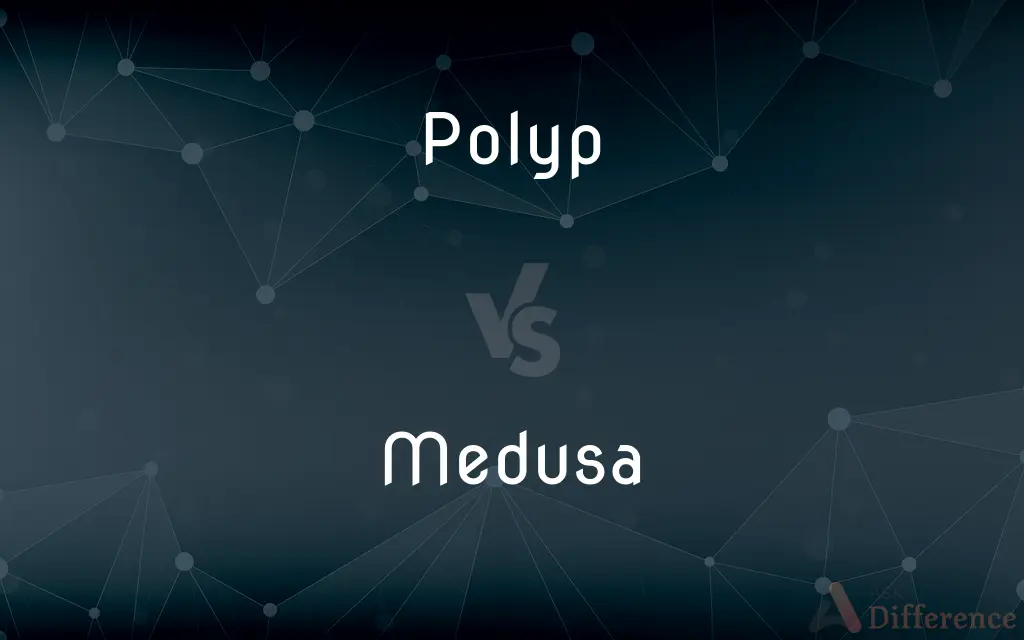Polyp vs. Medusa — What's the Difference?
Edited by Tayyaba Rehman — By Fiza Rafique — Updated on March 21, 2024
Polyps are sessile life stages of cnidarians, characterized by a cylindrical body and a mouth surrounded by tentacles. Medusae are the mobile, bell-shaped life stages, known for their free-swimming ability.

Difference Between Polyp and Medusa
Table of Contents
ADVERTISEMENT
Key Differences
Polyps represent one of the two primary life stages in the life cycle of cnidarians, such as corals and sea anemones. They are typically sessile, attaching to a substrate with a cylindrical body and an upward-facing mouth surrounded by tentacles used for feeding and defense. On the other hand, medusae refer to the free-swimming life stage of certain cnidarians, including jellyfish, characterized by a bell-shaped body that pulsates for locomotion, with tentacles hanging downward for capturing prey.
The polyp stage is generally asexual, reproducing through budding, where new individuals grow directly from the parent organism. This contributes to the growth of colonial structures in species like corals. Medusae, in contrast, are primarily involved in the sexual reproduction phase of the cnidarian life cycle, releasing sperm and eggs into the water for external fertilization.
Polyps are adapted to a benthic lifestyle, meaning they live attached to the ocean floor or other surfaces in the marine environment. They often form colonies that can grow into large reef structures or anemone clusters, providing habitats for other marine species. Medusae are adapted to a pelagic (open water) lifestyle, with their bell-shaped bodies and tentacles allowing them to drift and swim through the ocean, capturing prey with their stinging cells.
The transition between polyp and medusa can occur through a process called metamorphosis, where a polyp undergoes significant morphological changes to become a medusa. This transition is part of a complex life cycle that allows cnidarians to exploit different ecological niches and increase their chances of survival and reproduction. While some cnidarians only exist as polyps or medusae, others like certain jellyfish species, exhibit both stages at different times in their life cycle.
Polyps and medusae have cnidocytes, specialized cells containing nematocysts (stinging structures) used for capturing prey and defense. While the structural arrangement and function of these cells are similar in both forms, their orientation and role differ due to the contrasting lifestyles and body forms of polyps and medusae.
ADVERTISEMENT
Comparison Chart
Body Shape
Cylindrical, sessile
Bell-shaped, free-swimming
Life Stage
Often asexual and sessile
Often involved in sexual reproduction, mobile
Habitat
Attached to the ocean floor or other surfaces
Pelagic, drifting or swimming in open water
Reproduction
Asexual reproduction through budding
Sexual reproduction, releasing gametes into the water
Examples
Corals, Sea Anemones
Jellyfish, some species of Hydrozoa
Compare with Definitions
Polyp
Adapted to a fixed existence, often forming colonies.
Coral reefs are formed by the calcareous skeletons of polyp colonies.
Medusa
Bell-shaped body allows for mobility in water.
Jellyfish use their bell-like structure to pulsate and propel through the water.
Polyp
Uses tentacles to capture prey, with mouth facing upwards.
Polyps capture tiny marine organisms by ensnaring them with their tentacles.
Medusa
Adapted to life in the open water, often in the water column.
Many medusae are found in pelagic zones, from surface waters to the deep sea.
Polyp
Contributes to marine biodiversity by forming habitats.
Coral polyps build reefs that provide shelter and food for a myriad of marine species.
Medusa
Plays a key role in the sexual phase of the cnidarian life cycle.
Adult jellyfish release sperm and eggs into the water, where fertilization occurs.
Polyp
Primarily reproduces through budding.
Sea anemones can reproduce by budding, where new individuals branch off from the parent.
Medusa
Dangles tentacles downward to capture prey.
Medusae often drift or swim slowly, catching plankton and small fish with their tentacles.
Polyp
Equipped with stinging cells for defense and prey capture.
Polyps use cnidocytes to immobilize prey before ingestion.
Medusa
Utilizes stinging cells for capturing prey and defense while drifting.
The tentacles of a jellyfish are lined with cnidocytes that stun or kill prey upon contact.
Polyp
A body form of a cnidarian, such as a hydra or coral, that is cylindrical in shape, has a mouth usually surrounded by tentacles at one end, and is often attached to something at the other end.
Medusa
In Greek mythology, Medusa (; Ancient Greek: Μέδουσα "guardian, protectress") also called Gorgo, was one of the three monstrous Gorgons, generally described as winged human females with living venomous snakes in place of hair. Those who gazed into her eyes would turn to stone.
Polyp
A usually nonmalignant growth or tumor protruding from the mucous lining of an organ such as the nose, bladder, or intestine, sometimes causing obstruction.
Medusa
The Gorgon who was killed by Perseus.
Polyp
(medicine) An abnormal growth protruding from a mucous membrane.
Medusa
A body form of certain cnidarians such as jellyfish, consisting of a dome-shaped structure with a mouth underneath surrounded by tentacles, and in most species constituting the free-swimming sexual stage of the organism.
Polyp
(zoology) A cylindrical coelenterate, such as the hydra, having a mouth surrounded with tentacles.
Medusa
(zoology) A jellyfish; specifically, a non-polyp form of individual cnidarians, consisting of a gelatinous umbrella-shaped bell and trailing tentacles.
Polyp
One of the feeding or nutritive zooids of a hydroid or coral.
Medusa
(pathology) worm-star
Polyp
A small vascular growth on the surface of a mucous membrane
Medusa
The Gorgon; or one of the Gorgons whose hair was changed into serpents, after which all who looked upon her were turned into stone.
Polyp
One of two forms that coelenterates take e.g. a hydra or coral: usually sedentary and has a hollow cylindrical body usually with a ring of tentacles around the mouth
Medusa
Any free swimming acaleph; a jellyfish.
Medusa
(Greek mythology) a woman transformed into a Gorgon by Athena; she was slain by Perseus
Medusa
Any of numerous usually marine and free-swimming coelenterates that constitute the sexually reproductive forms of hydrozoans and scyphozoans
Medusa
One of two forms that coelenterates take: is the free-swimming sexual stage in the life cycle of a coelenterate and has a gelatinous umbrella-shaped body and tentacles
Common Curiosities
Why are medusae important for cnidarian reproduction?
Medusae are typically involved in the sexual reproduction phase, helping to spread the genetic diversity of cnidarians through gamete release.
Do all cnidarians have both polyp and medusa stages?
No, some cnidarians exist only as polyps or medusae throughout their life, depending on their species and environmental conditions.
What is the main difference between a polyp and a medusa?
Polyps are sessile and cylindrical, mainly reproducing asexually, while medusae are mobile, bell-shaped, and often involved in sexual reproduction.
What adaptations do medusae have for a pelagic lifestyle?
Medusae have bell-shaped bodies for propulsion and tentacles for capturing prey in the open water.
How do polyps and medusae capture their prey?
Both use cnidocytes in their tentacles to stun or kill prey, but polyps have upward-facing mouths, while medusae have tentacles that hang down.
Can cnidarians switch between polyp and medusa forms?
Yes, many cnidarians have life cycles that include both polyp and medusa stages, transitioning through metamorphosis.
How do polyps reproduce asexually?
Through processes like budding, where new individuals grow from the body of the parent polyp.
How do polyps contribute to the marine ecosystem?
Polyps, like corals, form structures that provide habitats for a diverse range of marine life, supporting biodiversity.
What role do medusae play in the ocean food chain?
Medusae serve as both predators of smaller marine organisms and prey for larger animals, including some species of fish, turtles, and birds.
Are polyp colonies always formed by the same species?
Yes, polyp colonies typically consist of genetically identical individuals of the same species, resulting from asexual reproduction.
Can polyps move?
Polyps are generally sessile but can exhibit minor movements, such as contracting their bodies or extending and retracting their tentacles.
Share Your Discovery

Previous Comparison
Boeing vs. Airbus
Next Comparison
Compensation vs. FeeAuthor Spotlight
Written by
Fiza RafiqueFiza Rafique is a skilled content writer at AskDifference.com, where she meticulously refines and enhances written pieces. Drawing from her vast editorial expertise, Fiza ensures clarity, accuracy, and precision in every article. Passionate about language, she continually seeks to elevate the quality of content for readers worldwide.
Edited by
Tayyaba RehmanTayyaba Rehman is a distinguished writer, currently serving as a primary contributor to askdifference.com. As a researcher in semantics and etymology, Tayyaba's passion for the complexity of languages and their distinctions has found a perfect home on the platform. Tayyaba delves into the intricacies of language, distinguishing between commonly confused words and phrases, thereby providing clarity for readers worldwide.
















































